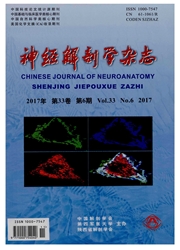

 中文摘要:
中文摘要:
目的:构建有效的小鼠神经型钙粘附蛋白(N-cadherin)基因RNA干扰质粒载体。方法:在小鼠基因库中选择3个靶序列并设计合成相应3对寡核苷酸序列,同时合成1对阴性对照寡核苷酸序列,然后将以上4对寡核苷酸序列退火后连入pSilencer^TM 3.1-H1 hygro质粒并分别命名为pSicad1、pSicad2、pSicad3、pSi-control。酶切和测序鉴定后,将以上重组质粒转染MN9D细胞,用Western Blot和半定量RT-PCR方法检测N-cadherin基因mR-NA和蛋白的表达水平。结果:酶切和测序证实目的寡核苷酸片段已被准确克隆到pSilencer^TM 3.1-H1 hygro质粒,与对照组相比,pSicad2和pSicad3转染MN9D细胞后,N-cadherin mRNA和蛋白水平的表达均受到明显抑制,其中N-cadherin蛋白水平在pSicad3组下降50%(P〈0.01)。结论:结果表明已成功构建了小鼠N-cadherin基因RNAi质粒载体,为N-cadherin功能研究奠定了基础。
 英文摘要:
英文摘要:
Objective:To construct a plasmid vector of RNA interference (RNAi) of N-cadherin gene in mice. Methods:First,three target sequences were selected corresponding to N-cadherin mRNA sequence from a mice gene pool. Three pairs of oligonucleotide sequences as well as one pair of negative control oligonucleotide sequence were designed and synthesized. Subsequently,the oligonucleotide fragments were annealed and connected into pSilencer^TM 3.1-H1 hygro plasmids; the resulting plasmid vectors were named pSicad1,pSicad2,pSicad3 and pSi-control,respectively. Next,restriction enzyme was used to digest and sequence them for verification. Afterwards,the verified recombinant plasmids were transfected into MN9D cells. N-cadherin expression in the transfected cells was assayed by semi-quantitative RT-PCR and Western-blot techniques. Results:The results indicates that the oligonucleotide fragments were cloned into pSilencer^TM 3.1-H1 hygro plasmids accurately. N-cadherin expression in the transfected cells was inhibited significantly by pSicad2 and pSicad3 at both the protein and mRNA level compared with those in the control group. N-cadherin protein was reduced by a percentage of 50% in pSicad3 group,respectively,which was significantly different from that in the control group (P〈0.01). Conclusion:These results suggest that RNAi plasmid vectors of N-cadherin can be constructed successfully and used to illuminate the function of N-cadherin gene further.
 同期刊论文项目
同期刊论文项目
 同项目期刊论文
同项目期刊论文
 期刊信息
期刊信息
